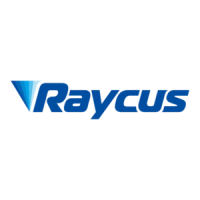
Do you have a question about the Raycus RFL-C Series and is the answer not in the manual?
| Brand | Raycus |
|---|---|
| Model | RFL-C Series |
| Category | Measuring Instruments |
| Language | English |
Identifies safety warnings and hazards related to laser operation.
Classifies the laser according to standards and outlines risks of exposure.
Explains various safety labels and their meanings for hazard identification.
Provides guidelines to prevent damage to optical components and the lens.
Outlines critical electrical safety measures for grounding and power supply.
Lists fundamental safety practices for laser operation and maintenance.
Highlights the main characteristics and benefits of the fiber laser.
Details the structure and meaning of the laser model naming convention.
Lists items included in the package and procedures for unpacking and inspection.
Specifies the optimal conditions for laser installation and operation.
Lists critical points to observe for correct operation and to prevent damage.
Provides detailed technical data and operating parameters of the laser.
Details the external size and layout of the laser unit.
Guides on the size, installation, and care of the fiber optic output cable.
Specifies requirements and procedures for installing the laser's cooling system.
Outlines essential rules and precautions for correctly installing the laser.
Describes the components and indicators on the laser's front panel.
Details the connectors and controls located on the laser's rear panel.
Provides instructions for safely connecting the laser to the power supply.
Explains the DB25 control interface and its pin definitions.
Details the RS-232 serial port definition and configuration parameters.
Guides on setting up the Ethernet TCP/IP interface for communication.
Provides a sequential guide for the physical installation of the laser.
Details the correct order of operations for powering on and starting the laser.
Describes the main interface and general functions of the control software.
Explains detailed functions within the control interface like parameter setting.
Describes how alarm information is displayed and updated in real-time.
Shows where to find laser information like model, serial number, and system details.
Allows setting the preferred language for the software interface.
Details the interface for managing laser time locks and authorization codes.
Explains different software operating modes: monitor, control, debug, diagnostic.
Describes the main control module interface for status and parameter monitoring.
Details the slave control module interface for power surveillance and CAN communication.
Explains different control modes and their wiring diagrams.
Guides on operating the laser in stand-alone mode with internal control.
Describes operating the laser using external signals for modulation and control.
Explains controlling laser power via analog voltage through the DB25 interface.
Illustrates timing diagrams for various control sequences and modes.
Details how to enable and control the laser's red light indicator.
Outlines the correct steps for safely powering down the laser system.
Guides on logging into the mobile application for laser control.
Details the process of connecting the mobile app to the laser device.
Shows how to view laser status, alarms, and parameters via the app.
Explains the equipment alarm page and how alarms are indicated.
Guides on configuring laser parameters through the app's settings interface.
Details how to lock or unlock the laser using device authorization codes.
Describes the 'My page' section for function introduction, version update, and machine info.
Provides an overview of the mobile software's purpose and benefits.
Illustrates the typical workflow for using the mobile app with the laser.
Illustrates how alarm states are shown on the control software interface.
Lists common alarms with instructions and possible solutions for resolution.
Defines the standard warranty coverage for Raycus fiber laser products.
Specifies conditions and situations not covered by the product warranty.
Provides guidelines for product service, repair, and contact procedures.